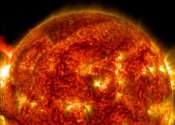New supercluster discovered by astronomers
By analyzing the data from the eROSITA Final Equatorial Depth Survey (eFEDS), an international team of astronomers has detected a new supercluster. The newly found structure consists of eight galaxy clusters. The discovery ...









